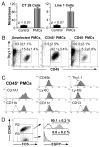Circulating fibrocytes prepare the lung for cancer metastasis by recruiting Ly-6C+ monocytes via CCL2
- PMID: 23536638
- PMCID: PMC3740355
- DOI: 10.4049/jimmunol.1202857
Circulating fibrocytes prepare the lung for cancer metastasis by recruiting Ly-6C+ monocytes via CCL2
Abstract
Fibrocytes are circulating, hematopoietic cells that express CD45 and Col1a1. They contribute to wound healing and several fibrosing disorders by mechanisms that are poorly understood. In this report, we demonstrate that fibrocytes predispose the lung to B16-F10 metastasis by recruiting Ly-6C(+) monocytes. To do so, we isolated fibrocytes expressing CD45, CD11b, CD13, and Col1a1 from the lungs of wild type (WT) and Ccr5(-/-) mice. WT but not Ccr5(-/-) fibrocytes increased the number of metastatic foci when injected into Ccr5(-/-) mice (73 ± 2 versus 32 ± 5; p < 0.001). This process was MMP9 dependent. Injection of WT enhanced GFP(+) fibrocytes also increased the number of Gr-1(Int), CD11b(+), and enhanced GFP(-) monocytes. Like premetastatic-niche monocytes, these recruited cells expressed Ly-6C, CD117, and CD45. The transfer of these cells into Ccr5(-/-) mice enhanced metastasis (90 ± 8 foci) compared with B cells (27 ± 2), immature dendritic cells (31 ± 6), or alveolar macrophages (28 ± 3; p < 0.05). WT and Ccl2(-/-) fibrocytes also stimulated Ccl2 expression in the lung by 2.07 ± 0.05- and 2.78 ± 0.36-fold compared with Ccr5(-/-) fibrocytes (1.0 ± 0.06; p < 0.05). Furthermore, WT fibrocytes did not increase Ly-6C(+) monocytes in Ccr2(-/-) mice and did not promote metastasis in either Ccr2(-/-) or Ccl2(-/-) mice. These data support our hypothesis that fibrocytes contribute to premetastatic conditioning by recruiting Ly-6C(+) monocytes in a chemokine-dependent process. This work links metastatic risk to conditions that mobilize fibrocytes, such as inflammation and wound repair.
Conflict of interest statement
The authors have no financial conflicts of interest.
Figures





Similar articles
-
Accumulation of CD11b+ lung dendritic cells in response to fungal infection results from the CCR2-mediated recruitment and differentiation of Ly-6Chigh monocytes.J Immunol. 2009 Dec 15;183(12):8044-53. doi: 10.4049/jimmunol.0902823. J Immunol. 2009. PMID: 19933856 Free PMC article.
-
CCL2, but not its receptor, is essential to restrict immune privileged central nervous system-invasion of Japanese encephalitis virus via regulating accumulation of CD11b(+) Ly-6C(hi) monocytes.Immunology. 2016 Oct;149(2):186-203. doi: 10.1111/imm.12626. Epub 2016 Jul 12. Immunology. 2016. PMID: 27260136 Free PMC article.
-
C-C chemokine receptor 5 on pulmonary fibrocytes facilitates migration and promotes metastasis via matrix metalloproteinase 9.Am J Pathol. 2008 Jul;173(1):253-64. doi: 10.2353/ajpath.2008.070732. Epub 2008 Jun 5. Am J Pathol. 2008. PMID: 18535183 Free PMC article.
-
Fibrocytes in the Tumor Microenvironment.Adv Exp Med Biol. 2020;1224:79-85. doi: 10.1007/978-3-030-35723-8_6. Adv Exp Med Biol. 2020. PMID: 32036606 Free PMC article. Review.
-
Fibrocytes in Fibrotic Diseases and Wound Healing.Adv Wound Care (New Rochelle). 2012 Feb;1(1):36-40. doi: 10.1089/wound.2011.0310. Adv Wound Care (New Rochelle). 2012. PMID: 24527276 Free PMC article. Review.
Cited by
-
Cross-talk between lung cancer and bones results in neutrophils that promote tumor progression.Cancer Metastasis Rev. 2018 Dec;37(4):779-790. doi: 10.1007/s10555-018-9759-4. Cancer Metastasis Rev. 2018. PMID: 30203108 Free PMC article. Review.
-
Tumor-associated macrophages in human breast cancer produce new monocyte attracting and pro-angiogenic factor YKL-39 indicative for increased metastasis after neoadjuvant chemotherapy.Oncoimmunology. 2018 Mar 13;7(6):e1436922. doi: 10.1080/2162402X.2018.1436922. eCollection 2018. Oncoimmunology. 2018. PMID: 29872578 Free PMC article.
-
Stress-induced Norepinephrine Downregulates CCL2 in Macrophages to Suppress Tumor Growth in a Model of Malignant Melanoma.Cancer Prev Res (Phila). 2020 Sep;13(9):747-760. doi: 10.1158/1940-6207.CAPR-19-0370. Epub 2020 Jun 9. Cancer Prev Res (Phila). 2020. PMID: 32518084 Free PMC article.
-
Pericytes in the Premetastatic Niche.Cancer Res. 2018 Jun 1;78(11):2779-2786. doi: 10.1158/0008-5472.CAN-17-3883. Epub 2018 May 22. Cancer Res. 2018. PMID: 29789421 Free PMC article. Review.
-
Meaningful prevention of breast cancer metastasis: candidate therapeutics, preclinical validation, and clinical trial concerns.J Mol Med (Berl). 2015 Jan;93(1):13-29. doi: 10.1007/s00109-014-1226-2. Epub 2014 Nov 22. J Mol Med (Berl). 2015. PMID: 25412774 Free PMC article. Review.
References
-
- Bucala R. Review Series – Inflammation & fibrosis fibrocytes and fibrosis. QJM. 2012;105:505–508. - PubMed
-
- Quan TE, Cowper S, Wu SP, Bockenstedt LK, Bucala R. Circulating fibrocytes: collagen-secreting cells of the peripheral blood. Int J Biochem Cell Biol. 2004;36:598–606. - PubMed
-
- Iqbal SA, Sidgwick GP, Bayat A. Identification of fibrocytes from mesenchymal stem cells in keloid tissue: a potential source of abnormal fibroblasts in keloid scarring. Arch Dermatol Res. 2012;304:665–671. - PubMed
-
- Todd JL, Palmer SM. Bronchiolitis obliterans syndrome: the final frontier for lung transplantation. Chest. 2011;140:502–508. - PubMed
Publication types
MeSH terms
Substances
Grants and funding
LinkOut - more resources
Full Text Sources
Other Literature Sources
Medical
Molecular Biology Databases
Research Materials
Miscellaneous

